Browse 6,500 images by the photographer who captured Los Angeles in the making. Co-published with Artstor.
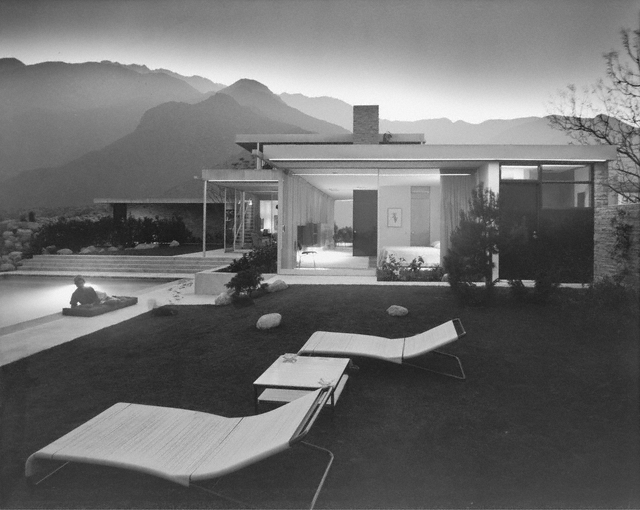
Kaufmann House by architect Richard Neutra, Palm Springs, CA, 1947. Julius Shulman photography archive. The Getty Research Institute, 2004.R.10
The Getty Research Institute recently collaborated with the Artstor Digital Library to digitize and share approximately 6,500 images from the Julius Shulman photography archive, series II and III. The work of American architectural photographer Julius Shulman (1910–2009) comprises the most comprehensive visual chronology of modern architecture in the Americas, with a detailed focus on the development of the Los Angeles region. Spanning 70 years, it is a critical visual record of the metropolis’s evolution. The images are available now both on Artstor, a subscription database for research and teaching, and in the Getty Research Institute’s digital collections.
Within Artstor, Julius Shulman’s iconic imagery can be explored alongside photographs by his contemporaries, such as Ezra Stoller, and Wayne Andrews. Shulman’s images can also be leveraged for study and teaching together with images offered by SAHARA, the Society of Architectural Historians Architecture Resources Archive.
Shulman’s Series II and III are of particular importance to the archive, and include some of his most renowned work. Series II contains photographs of architects who commissioned Shulman on a regular basis. It is also the set of images that Shulman drew from most often for publishing or research; he separated the materials from the rest of his collection for easier access. Series II includes work by midcentury modern architects Richard Neutra, John Lautner, Paul Laszlo, Albert Frey, Rudolph Schindler, and William Cody, documenting most of their iconic buildings. Shulman’s relationship with these architects was often mutually beneficial: he was able to promote their work through his stunning representations of their spaces, and their superlative architecture in turn promoted Shulman’s skill, helping him acquire more commissions. In his book Architecture and Its Photography (1998), Shulman spoke of his images’ promotional capabilities:
Photography can enhance a building’s image by producing a graphic impact. It can address the development of an architect’s personal influence and an organization’s role in the creation of a statement that echoes the designs as well as the marketing values built into the organization of spaces, product displays, the standards of comfort enjoyed by an occupant of the facility.
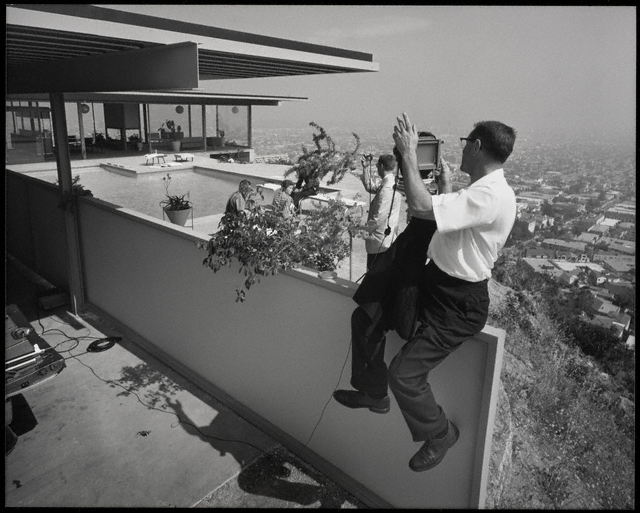
Julius Shulman photographing Case Study House no. 22, West Hollywood, 1960. Julius Shulman photography archive. The Getty Research Institute, 2004.R.10
A deep respect for the artistic fields of photography, architecture, and design is evident in Shulman’s pictures. The results of his collaborations with such masterful architects are a grand display elevating architectural art history. It’s no wonder that this group of architects turned to Shulman to represent their work again and again.
Series III in the Shulman archive contains photographs created as special projects, which the photographer maintained as separate groupings within his bigger collection of photographs. The first project in the series is the Case Study House Program initiated by John Entenza in 1945 and sponsored by Arts and Architecture magazine. Through the use of mass-produced construction materials, the program sought to exhibit superior affordable housing for typical American families in the postwar building market. Some houses were never realized and only exist in model or plan form, while others, such as Pierre Koening’s Case Study House #22 and the Eames House, aka Case Study House #8, are modern icons.
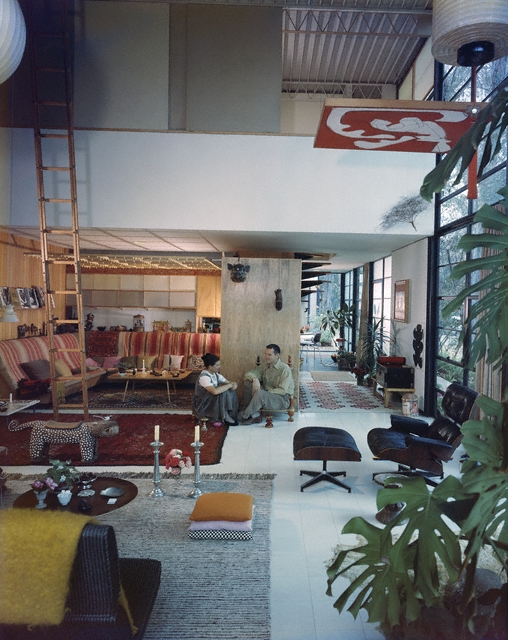
Case Study House #8: Charles and Ray Eames in their living room, Pacific Palisades, 1968. Julius Shulman photography archive. The Getty Research Institute, 2004.R.10
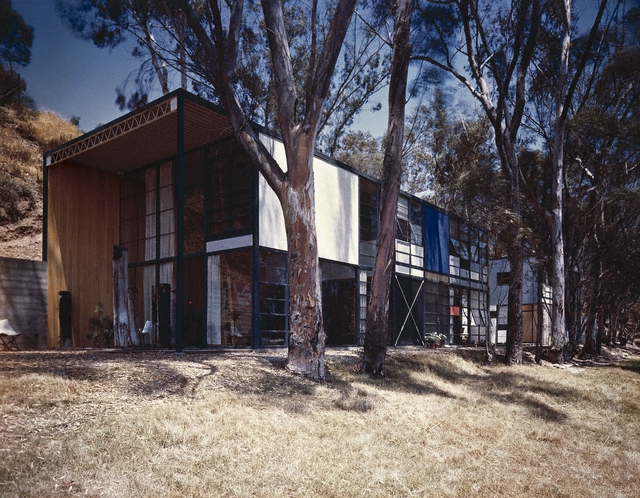
Case Study House #8 exterior, Pacific Palisades, 1968. Julius Shulman photography archive. The Getty Research Institute, 2004.R.10
The second project in series III is the illustrative photography Shulman created for a book by Stephanos Polyzoides, Roger Sherwood, and James Tice titled Courtyard Housing in Los Angeles. Courtyard housing grew in popularity during the 1920s and ‘30s, and the style is still very much a part of contemporary Los Angeles architecture. The photographs capture the simplicity and charm of courtyard buildings as explored by Shulman and the book authors in the Los Angeles landscape.
The remaining project in series III is Shulman’s survey of sites from the Los Angeles Cultural Heritage Board covering a range of landmarks including historic trees, a funicular railway, public art, and the ornately detailed structures from the late 1800s and early 1900s that L.A.’s founders built to emulate the strength and status of influential American cities to the east. This series is of particular value both because Shulman captured many structures in their original contexts, and because many of these buildings have been destroyed, relocated, or are now surrounded by more highly developed business or residential areas. His photographs serve as a record of time, showing a moment in the midst of a rapidly developing cityscape.

Angels’ Flight railway, Los Angeles, 1964. Julius Shulman photography archive. The Getty Research Institute, 2004.R.10
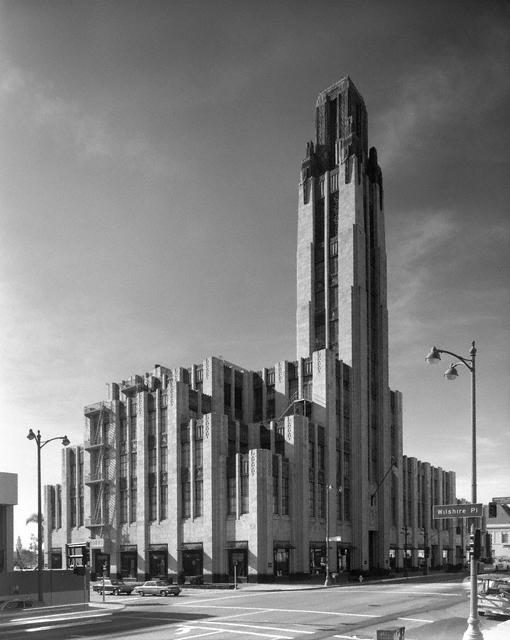
Bullock’s Wilshire, Los Angeles, 1969. Julius Shulman photography archive. The Getty Research Institute, 2004.R.10

Simon Rodia’s Watts Towers, Los Angeles, 1967. Julius Shulman photography archive. The Getty Research Institute, 2004.R.10

Union Station, Los Angeles, 1973. Julius Shulman photography archive. The Getty Research Institute, 2004.R.10
Taken together, Shulman’s series II and III give a focused look at Southern California architecture and the important architects who shaped its landscape. Easy access to the images via the GRI’s digital collections will provide expansive research opportunities for this large body of work.
Find all newly digitized Shulman images for study, teaching, and personal use on the Getty Research Institute’s digital collections here, and on ARTStor here. Most images are also part of ARTStor’s Images for Academic Publishing, which makes high-resolution images freely available for use in academic publications. To request high-resolution images for use in other publications, contact the Getty Research Institute. Due to the inclusion of artworks not in the public domain, privacy and publicity concerns, and/or contractual requirements, the images are not available for unrestricted use via the Open Content Program.



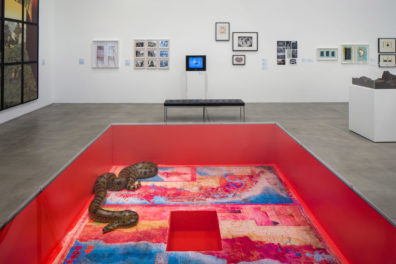
WAS THERE A USUAL EDITION SIZE OF THE SHULMAN PHOTOGRAPHS ?
I WAS SHOWN A PRINT RECENTLY IN AN EDITION SIZE OF 250 & WONDER
IF THAT’S A USUAL NUMBER.